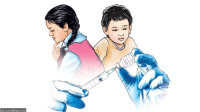Health
After missing the measles elimination deadline, the government is planning to extend it by five years
To achive eliminated status, number of cases should be less than five in every 1,000,000 population, or no cases throughout the year.Arjun Poudel
After missing the 2019 deadline to eliminate measles and rubella, the government says it is left with no option than to extend the timeframe by another four-five years, as efforts to contain the two diseases are not yielding desired results.
“We have been working to extend the deadline for elimination of measles and rubella,” said Dr Jhalak Sharma, chief of immunisation section at the Family Welfare Division of the Department of Health Services. “We have been discussing the new deadline with all concerned stakeholders, including the World Health Organization, UNICEF and others.”
Measles is a contagious viral disease that can be entirely prevented with a two-dose vaccine, first administered at nine months of age and the second at 15 months. The government provides measles vaccines for free from health facilities across the country.
To achieve measles eliminated status, the number of cases should be less than five in every 1,000,000 population, or no cases throughout the year.
According to Dr Sharma, his office could not achieve the target due to the frequent measles outbreak in various parts of the country. Outbreaks of the contagious disease were reported from Morang, Dang, Kapilvastu and some other districts in 2019.
“We are still struggling to increase the immunisation coverage rate of measles and rubella vaccines,” said Sharma. “The coverage rate of the vaccine is around 80 percent but our target should be over 90 percent to achieve measles eliminate status.”
Dr Sharma said the low coverage of measles and rubella vaccines in several districts of Province 2 was a cause for concern as some districts in the province have less than 40 percent coverage rate.
In the fiscal year 2017-18, the coverage rate of the second dose of measles and rubella vaccines was only 35 percent in Sarlahi and 46 percent in Rautahat districts. In the same fiscal year, Manang and Lalitpur districts had 45 percent coverage rate each, whereas Kathmandu had just 46 percent, according to the immunisation section.
Out of over 650,000 children in need of measles-rubella vaccines every year, 120, 000 (about 20 percent) miss their inoculation schedule. Doctors say that chances of the deadly viral disease spreading get higher if even one child misses immunisation.
The Ministry of Health and Population has been planning to launch a measles-rubella drive within 2019 throughout the country in which children from nine months to five years of age would be immunised with anti-measles and rubella vaccines. The drive is supposed to cover over three million children.
The ministry said it is necessary to run the measles and rubella campaign as the number of children missing the vaccines would grow exponentially in its absence over the years, leading to high chances of a disease outbreak.
Measles was endemic in Nepal and an average of 90,000 cases were recorded every year from 1994 to 2004. Routine measles vaccination began in the country in 1979 with three districts. The campaign was expanded nationwide after 10 years.
Measles is transmitted through droplets from the nose, mouth or throat of infected persons. Early symptoms, which usually appear 10-12 days after infection includes high fever, runny nose, bloodshot eyes and white tiny spots inside the mouth. Several days later, a rash develops on the face, upper neck and other parts of the body.
In April, the World Health Organisation published an alarming report—that measles cases across the world rose 300 percent in the first three months of 2019 compared to the same period last year.
For countries across the globe, the findings were a cause for concern because the UN health agency said though they were provisional and not yet complete, the rise in measles cases indicated.
Doctors say people of all age groups are vulnerable to the disease and underage children, pregnant women, elderly people and those with compromised immune systems—HIV infected people—are highly vulnerable.Some people may suffer from severe complications, such as pneumonia, encephalitis and the infection could also lead to death among.



 11.12°C Kathmandu
11.12°C Kathmandu














